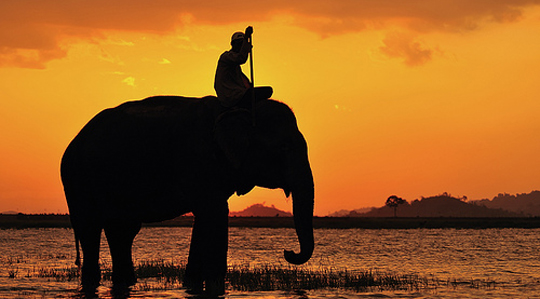
There was something unusual about the popcorn they received. It was wretched. In fact, it had been carefully engineered to be wretched. It had been popped five days earlier and was so stale that it squeaked when you ate it. One moviegoer later compared it to Styrofoam packing peanuts, and two others, forgetting that they’d received the popcorn for free, demanded their money back.
Some of them got their free popcorn in a medium-size bucket, and others got a large bucket – the sort of huge tub that looks like it might once have been an above-ground swimming pool Every person got a bucket so there’d be no need to share. The researchers responsible for the study were interested in a simple question: Would people with bigger buckets eat more?
Both buckets were so big that none of the moviegoers could finish their individual portions. So the actual research question was a bit more specific: Would somebody with a larger inexhaustible supply of popcorn eat more than someone with a smaller inexhaustible supply?
The sneaky researchers weighed the buckets before and after the movie, so they were able to measure precisely how much popcorn each person ate. The results were stunning: People with the large buckets ate 53 percent more popcorn than the people with the medium size. That’s the equivalent of 173 more calories and approximately 21 extra-hand dips into the bucket.
Brian Wansink, the author of the study, runs the Food and Brand Lab at Cornell University, and he described the results in his book Mindless Eating: ‘We’ve run other popcorn studies, and the results were always the same, however we tweaked the details. It didn’t matter if our moviegoers were in Pennsylvania, Illinois, or Iowa, and it didn’t matter what kind of movie was showing; all of our popcorn studies led to the same conclusion. People eat more when you give them a bigger container. Period.’
No other theory explains the behaviour. These people weren’t eating for pleasure. (The popcorn was so stale it squeake!) They weren’t driven by a desire to finish their portion. (Both buckets were too big to finish.) It didn’t matter whether they were hungry or full. The equation is unyeilding: Bigger container = more eating.
Best of all, people refused to believe the test results. After the researchers told the moviegoers about the two bucket sizes and the findings of their past research. The researchers asked, Do you think you ate more because of the larger size? The majority scoffed at the idea, saying, ‘Things like that don’t trick me,’ or, ‘I’m pretty good a knowing when I’m full.’
Whoops.
Imagine that someone showed you the data from the popcorn eating study but didn’t mention the bucket sizes. On your data summary, you could quickly scan the results and see how much popcorn different people ate – some people ate a little, some ate a lo, and some people seemed to be testing the physical limits of the human stomach. Armed with a data set like that, you would find it easy to jump to conclusions. Some people are Reasonable Snackers, and others Big Gluttons.
A public-health expert, studying that data alongside you, would likely get very worried about the Gluttons. We need to motivate these people to adopt healthier snacking behaviours! Lets find ways to show them the health hazards of eating so much!
But wait a second. If you want people to eat less popcorn, the solution is pretty simple: Give them smaller buckets. You don’t have to worry about their knowledge or their attitudes.
You can see how easy it would be to turn an easy change problem (shrinking people’s buckets) into a hard change problem (convincing people to think differently). And that’s the first surprise about the change: What looks like a people problem is often the situation problem.
This is a book to help you change things. We consider change at every level – individual, organizational, and societal. Maybe you want to help your brother beat his gambling addiction. Maybe you need your team at work to act more frugally because off market conditions. Maybe you wish more of your neighbours would bike to work.
Usually these topics are treated separately – there is a ‘change management’ advice for executives and ‘self-help’ advice for individuals and ‘change the world’ advice for activists. That’s a shame, because all change efforts have something in common: For anything to change, someone has to start acting differently. Your brother has to stay out of the casino; your employees have got to start booking coach fares. Ultimately, all change efforts boil down to the same mission: Can you get people to start behaving in a new way?
We know what you’re thinking – people resist change. But it’s not quite that easy. Babies are born every day to parents who, inexplicably, welcome the change. Think about the sheer magnitude of their change! Would anyone agree to work for a boss who’d wake you up twice a night, screaming, for trivial administrative duties? (And what if, every time you wore a new piece of clothing, the boss spit up on it?) Yet people don’t resist this massive change – they volunteer for it.
In our lives, we embrace lots of big changes – not only babies, but marriages and new homes and new technologies and new job duties. Meanwhile, other behaviours are maddeningly intractable. Smokers keep smoking and kids grow fatter and your husband can’t ever seem to get his dirty sheets into a hamper.
So there are hard changes and easy changes. What distinguishes one from the other? In this book, we argue that successful changes share a common pattern. They require the leader of the change to do three things at once. We’ve already mentioned one of those three things: To change someone’s behaviour, you’ve got to change that person’s situation.
The situation isn’t the whole game, of course. You can send an alcohoic to rehab, where the new environment will help him go dry. But what happens when he leaves and loses that influence? You might see a boost in productivity from your sales reps when the sales manager shadows them, but what happens afterward when the situation returns back to normal? For individuals’ behaviour to change, you’ve got to influence not only their environment but their hearts and minds.
The problem is this: Often the heart and mind disagree. Fervently.
Consider the Clocky, an alarm clock invented by an MIT student, Gauri Nanda. It’s no ordinary alarm clock – it has wheels. You set it off at night, and in the morning when the alarm goes off, it rolls off your nightstand and scurries around the room, forcing you to chase it down. Picture the scene: You’re crawling around the bedroom in your underwear, stalking and cursing a runaway clock.
Clocky ensures that you won’t snooze-button your way to disaster. And apparently that’s a common fear, since about 35,000 units were purchased, at $50 each, in Clocky’s first two years on the market (despite minimal marketing).
The success of this invention reveals a lot about human psychology. What is shows, fundamentally, is that we are schizophrenic. Part of us – our rational side – wants to get up at 5:45 a.m., allowing ourselves plenty of time for a quick jog before we leave for the office. The other part of us – the emotional side – wakes up in the darkness of the early morning, snoozing inside a warm cocoon of sheets and blankets, and wants nothing in the world so much as a few minutes of sleep. If, like us, your emotional side tends to win these internal debates, then you might be a potential Clocky customer. The beauty of the device is that it allows your rational side to outsmart your emotional side. It’s simply impossible to stay cuddled up under the covers when a rogue alarm clock is rolling around your room.
Let’s be blunt here: Clocky is not a product for a sane species. If Spock wants to get up a 5:45 a.m., he’ll just get up. No drama required.
Our built-in schizophrenia is a deeply weird thing, but we don’t think much about it because we’re so used to it. When we kick off a new diet, we toss the Cheetos and Oreos out of the pantry, because our rational side knows that when our emotional side gets a craving, there’s no hope of self-control. The only operation is to remove the temptation all together. (For the record, some MIT student will make a fortune designing Cheetos that scurry away from people when they’re on a diet.)
The unavoidable solution is this: Your brain isn’t one of mind.
The conventional wisdom in psychology, in fact, is that the brain has two independent systems at work at all times. First, there’s what we called the emotional side. It’s the part of you that’s instinctive, that feels pain and pleasure. Second, there’s the rational side, also known as the reflective or conscious system. It’s the part of you that deliberates and analyzes and looks in to the future.
In the past few decades, psychologists have learned a lot about these two systems, but of course mankind has always been aware of the tension. Plate said that in our heads we have a rational charioteer who has to rein in an unruly horse that ‘barely yields to horsewhip and goad combined.’ Freud wrote about the selfish id and the conscientious superego (and also about the ego, which mediates between them). More recently, behavioural economists dubbed the two systems the Planner and the Doer.
But, to us, the duo’s tension is captured best by analogy used by University of Virginia psychologist Jonathan Haidt in his wonderful book The Happiness Hypothesis. Haidt says that our emotional side is an Elephant and our rational side is its Rider. Perched atop the Elephant, the Rider holds the reins and seems to be the leader. But the Rider’s control is precarious because the Rider is so small relative to the Elephant. Anytime the six-ton Elephant and the Rider disagree about which direction to go, the Rider is going to lose. He’s completely overmatched.
Most of us are all too familiar with situations in which our elephant overpowers our Rider. You’ve experienced this if you’ve ever slept in, overeaten, dialed up your ex at midnight, procrastinated, tried to quit smoking and failed, skipped the gym, gotten angry and said something you regretted, abandoned your Spanish or piano lessons, refused to speak up in a meeting because you were scared, and so on. Good thing no one is keeping score.
The weakness of the Elephant, our emotional and instinctive side, is clear: It’s lazy and skittish, often looking for the quick payoff (ice cream cone) over the long-term payoff (being thin). when change efforts fail, it’s usually the Elephant’s fault, since the kinds of change we want typically involved short-term sacrifices for long term payoffs. (We cut back on expenses today to yield a better balance sheet next year. We avoid ice cream today for a better body next year.) Changes often fail because the Rider simply can’t keep the Elephant on the road long enough to reach the destination.
The Elephant’s hunger for instant gratification is the opposite of the Rider’s strength, which is the ability to think long-term, to plan, to think beyond the moment (all these things that your pet can’t do).
But what may surprise you is that the Elephant also has enormous strengths and that the Rider has crippling weaknesses. The Elephant isn’t always the bad guy. Emotion is the Elephant’s turf – love and compassion and sympathy and loyalty. That fierce instinct you have to protect your kids against harm – that’s the Elephant. That spine stiffening you feel when you need to stand up for yourself – that’s the Elephant.
And even more important if you’re contemplating a change, the Elephant is the one who gets things done. To make progress toward a goal, whether it’s noble or crass, requires the energy and drive of the Elephant. And this strength is the mirror image of the Rider’s great weakness: spinning his wheels. The Rider tends to overanalyze and overthing things. Chances are, you know people with Rider problems: your friend who can agonize for twenty minutes about what to eat for dinner; your colleague who can brainstorm about new ideas for hours but can’t ever seem to make a decision.
 If you want to change things, you’ve got to appeal to both. The Rider provides the planning and direction, and the Elephant provides the energy. So if you reach the Riders of your team but not the Elephants, team members will have understanding without motivation. If you reach their Elephants but not their Riders, they’ll have passion without direction. In both cases, the flaws can be paralyzing. a reluctant Elephant and a wheel-spinning Rider can both ensure that nothing changes. But when Elephants and Riders move together, change can come easily.
If you want to change things, you’ve got to appeal to both. The Rider provides the planning and direction, and the Elephant provides the energy. So if you reach the Riders of your team but not the Elephants, team members will have understanding without motivation. If you reach their Elephants but not their Riders, they’ll have passion without direction. In both cases, the flaws can be paralyzing. a reluctant Elephant and a wheel-spinning Rider can both ensure that nothing changes. But when Elephants and Riders move together, change can come easily.




